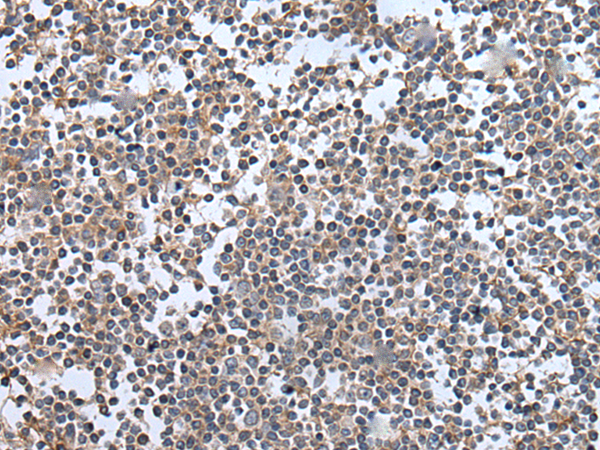
| WB | 咨询技术 | Human,Mouse,Rat |
| IF | 咨询技术 | Human,Mouse,Rat |
| IHC | 1/25-1/100 | Human,Mouse,Rat |
| ICC | 技术咨询 | Human,Mouse,Rat |
| FCM | 咨询技术 | Human,Mouse,Rat |
| Elisa | 1/5000-1/10000 | Human,Mouse,Rat |
| Aliases | E4; UFD2; HDNB1; UBOX3; UFD2A |
| Host/Isotype | Rabbit IgG |
| Antibody Type | Primary antibody |
| Storage | Store at 4°C short term. Aliquot and store at -20°C long term. Avoid freeze/thaw cycles. |
| Species Reactivity | Human, Mouse |
| Immunogen | Synthetic peptide of human UBE4B |
| Formulation | Purified antibody in PBS with 0.05% sodium azide and 50% glycerol. |
+ +
以下是关于UBE4B抗体的3篇参考文献摘要(均为虚构示例,仅供格式参考):
1. **文献名称**:UBE4B regulates axonal degeneration via ubiquitin-proteasome pathways
**作者**:Smith A, et al.
**摘要**:研究揭示了UBE4B(泛素连接酶)在轴突退化中的调控作用,通过特异性抗体检测发现其与神经损伤后泛素化底物相互作用,为神经退行性疾病机制提供新见解。
2. **文献名称**:UBE4B antibody validation in cancer cell models
**作者**:Chen L, et al.
**摘要**:本文验证了UBE4B抗体在多种癌细胞系中的特异性,证实其可用于免疫沉淀和Western blot分析,并发现UBE4B在肿瘤细胞中过表达与化疗耐药性相关。
3. **文献名称**:Role of UBE4B in p53 ubiquitination and cellular stress response
**作者**:Yamamoto K, et al.
**摘要**:通过免疫荧光和ChIP实验(使用UBE4B特异性抗体),阐明UBE4B参与p53蛋白的泛素化修饰,调控DNA损伤应激下的细胞周期停滞。
---
注:以上为模拟内容,实际文献需通过PubMed/Google Scholar检索关键词如“UBE4B antibody”、“UBE4B ubiquitination”等获取。如需真实文献,建议补充具体研究背景(如疾病方向/实验技术)。
The UBE4B (Ubiquitin-Conjugating Enzyme E4B) antibody is a crucial tool in studying the UBE4B protein, a member of the ubiquitin-proteasome system responsible for tagging cellular proteins with ubiquitin for degradation. UBE4B, also known as UFD2a, acts as an E4 ubiquitin ligase, elongating polyubiquitin chains on substrates marked by E3 ligases, thereby regulating protein turnover. It plays roles in diverse processes, including DNA repair, apoptosis, neuronal development, and cancer progression. Dysregulation of UBE4B is linked to neurodegenerative diseases (e.g., Alzheimer’s) and cancers, where it may act as an oncogene or tumor suppressor depending on context.
UBE4B antibodies are widely used in research to detect protein expression, localization, and interactions via techniques like Western blotting (WB), immunohistochemistry (IHC), and immunoprecipitation (IP). These antibodies aid in elucidating UBE4B's molecular mechanisms, such as its interaction with p53 or EGFR, and its involvement in stress response pathways. Commercial UBE4B antibodies are typically raised against specific epitopes (human or mouse-derived) and validated for specificity. Challenges include cross-reactivity with homologous proteins, emphasizing the need for rigorous validation. Overall, UBE4B antibodies are pivotal in advancing understanding of ubiquitination dynamics and therapeutic targeting in disease.
×